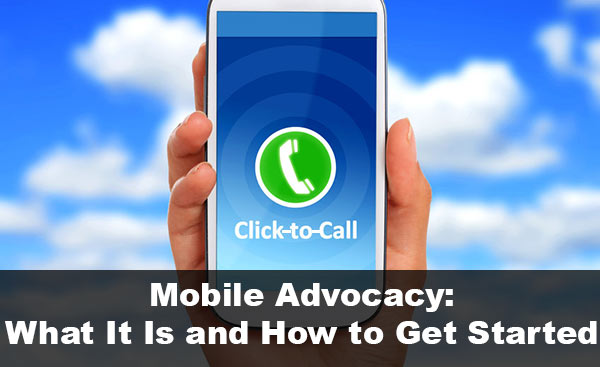Advocacy campaigns are a powerful way for nonprofits to make a difference in their communities. Raising awareness and support for a specific cause, these campaigns unify your nonprofit’s supporters to affect real change.
As with many other nonprofit activities, organizations are realizing how essential mobile elements are in the success of advocacy campaigns. By ensuring your campaign is accessible for supporters regardless of device and helping you stand out from the crowd, mobile advocacy is that extra push fueling modern campaigns.
This guide functions as an introduction to conducting a mobile advocacy campaign. We’ll start with a refresh on mobile advocacy overall before exploring 4 essential considerations for hosting a successful campaign. This guide will explore the following points:
- What is mobile advocacy?
- 4 Essential Considerations
- What are your goals?
- Who is your audience?
- Which mobile platforms should you use?
- How can you thank supporters after the fact?
By the end of this guide, you’ll understand the basics of creating a mobile advocacy campaign for your nonprofit. Let’s get started!

What is Mobile Advocacy?
To understand mobile advocacy, you must first understand advocacy campaigns in general.
Advocacy campaigns are efforts aiming to unite supporters in action toward a cause, policy, or other position. When nonprofits conduct these campaigns, they can take many forms— whether it’s raising general awareness, collecting signatures on a widely-shared petition, or even encouraging supporters to lobby their government representatives. Put simply, organizations use these campaigns to increase awareness of their cause.
There are three main types of advocacy:
- Peer advocacy, which refers to one-on-one advocacy for a cause. For example, speaking with a trusted friend about a cause you support.
- Cause advocacy, which refers to more broadly expressing support for a cause and raising general awareness. For example, participating in a cause awareness day is a form of cause advocacy.
- Systems advocacy, which refers to cause advocacy coupled with efforts to affect more direct change. This includes fundraising and lobbying.
Advocacy campaigns can span a wide variety of goals, as you can see in the list above. Therefore, there are also a plethora of different activities nonprofits take to make these goals a reality!
One of the rising stars in these activities is mobile advocacy.
Also read: 7 Crowdfunding Marketing Tips for Your Next Campaign
What’s different about mobile advocacy?
The key to any successful advocacy campaign is formulating the right message, and using it to reach the right audience at the exact right time. This is the equation for inspiring supporters to take action, and mobile technology is becoming an important component for any advocacy campaign.
In recent years, we’ve seen that more adults are viewing apps and web browsers via smartphones than desktop methods (nten.org). That means you’re more likely to reach supporters (the right audience) with your message via mobile, smartphone-friendly means than with content that’s desktop-accessible only.
Further, the nature of mobile content means it can be accessed at any time and from any place, increasing your chance of reaching that right audience at the right time. From there, all you need is the right message to share— and if you’re considering hosting an advocacy campaign, you probably already have that message in mind.
Are you convinced that mobile advocacy is the strategy for you? If so, continue reading for 4 essential considerations when building your campaign.
4 Essential Considerations for a Mobile Advocacy Campaign
1. What are your goals?
The first consideration when building your mobile advocacy campaign is defining what you hope to achieve. Specific goals will allow you to measure your success throughout the campaign.
Begin setting your goals by examining the data in your constituent relationship management (CRM) system. Regardless of what you hope to achieve, you’re going to want to set measurable goals to define success. Further, these goals should be realistic stretch goals— ambitious yet not impossible given the support your nonprofit already has access to.
Let’s look at an example:
- Overall goal: Improve the living conditions of homeless citizens in your local community.
- Specific goal: Convince the local government to pass a bill allocating higher funding to homeless citizens’ issues going forward.
- Measurable metric: Number of supporters that contact their representative via your Click-to-Call advocacy page on your website.
For the duration of your campaign, you’ll want to track the efforts toward your goals in your CRM. Then, you’ll have regular insight on where your campaign is succeeding and where it could use some help, and adjust your efforts as needed.
2. Who is your audience?
Determining the audience most likely to support your advocacy campaign is crucial before you begin your mobile outreach. There are two levels to this:
- Supporters most likely to support this specific cause.
- Supporters most likely to support this specific cause in a mobile manner.
You’ll want to identify individuals that have interacted with your nonprofit in the past that check off both boxes. For one, your advocacy campaign might cover one specific aspect of your nonprofit’s overall mission— and not every supporter will be interested. Further, it’s unlikely that every single past donor/volunteer/sponsor is going to be mobile-savvy and interested in interacting with your efforts in that manner.
It’s essential that you don’t deter future support by approaching people with a campaign that’s less-than interesting or confusing for them.
Once again, examine your CRM to gain insight into who your campaign’s audience is. Review past donor data to find those who have regularly, consistently, and loyally given to your cause across the board. You can also conduct prospect research, looking for potential future supporters with a strong affinity for your cause.
Finally, of those supporters, look for those that might be open to mobile outreach. Look for donors who prefer to give online, have engaged with your organization on social media, or have shared their cell number with you.
3. Which mobile platforms should you use?
As technology evolves, there are more and more ways to get supporters involved with your campaign through mobile means.
Let’s explore a few tech options to take your advocacy campaign to the mobile sphere:
- Advocacy software.
There are complete advocacy solutions, such as those in Salsa Labs’ guide to advocacy software, aimed at covering everything your nonprofit needs to host a successful campaign.
This includes mobile-optimized targeted action pages and online petitions. There are also tweet-a-rep social sharing tools perfect for supporters engaging their representatives on app-friendly social networks, and click-to-call functions automatically connecting supporters to their representatives via their cell phones!
- Advocacy apps.
Advocacy apps take the mobile experience a step further by creating a smartphone-only resource for supporters to access. The goal is to make your mobile campaign stand out from the crowd even more by creating a unique app specifically for advocacy.
These apps host all of the information supporters need to get involved in your advocacy campaign. This includes fundraising capabilities, in-app alerts, and push notifications.
- Social media.
All of the most popular social networks have a mobile app for users. Bringing your advocacy campaign to social media inherently takes it mobile. These apps are already mobile-optimized so any content you share is easily viewed from any device.
Use social networks to spread the word about your advocacy campaign and associate it with a hashtag to start building awareness. Take this a step further by providing advocates with nonprofit t-shirts and asking them to post pictures wearing the shirts across the networks.
- Text messaging.
There are two types of texting campaigns.
Text-to-Initiate campaigns encourage would-be supporters to text a keyword to a phone number (or text shortcode) to sign up for a mailing list, register for an event, etc. They receive an automated response back with the appropriate link. Broadcast text campaigns are similar to email campaigns in that you are “broadcasting” a message to a large group of supporters— via text messages.
Whether it’s information on rallies, sign-up forms, or instructions on how to contact representatives—text messaging is a great way to engage with your supporters. While email open rates can be low, over 90% of text messages are read!
Also read: How Mobile Bidding Can Benefit Your Next Charity Auction
4. How can you thank supporters after the fact?
The mobile aspect has the potential to drastically boost participation in your campaign, making it accessible to a wider audience. It might even make participation feel like a more casual choice! However, just as with traditional advocacy campaigns, it’s crucial that you thank supporters after the effort is over.
Brainstorm how you are going to thank supporters after the campaign ends. Donor thank-you letters and emails are a great place to start, but you can really get creative and draw on your mobile resources to take things to the next level!
For example, you could publicly thank mobile supporters on social networks or make personal phone calls to supporters that used your click-to-call offerings. Whatever you do, it’s important that supporters understand how appreciated they are.
Whatever your cause, whether a local issue like historic homes preservation or a worldwide issue like the plastics crisis, there’s a decent chance adding mobile elements to your advocacy campaign will have a positive effect.
Even if you’re not familiar with mobile advocacy, don’t fret! By considering your audience, goals, platforms, and methods of gratitude, you’ll cover all of the essentials for planning your first mobile advocacy campaign. With this guide, you’ll be off to a great start.
———–
About the Author:
Gerard Tonti is the Senior Creative Developer at Salsa Labs, the premier fundraising software company for growth-focused nonprofits.
Gerard’s marketing focus on content creation, conversion optimization and modern marketing technology helps him coach nonprofit development teams on digital fundraising best practices.

